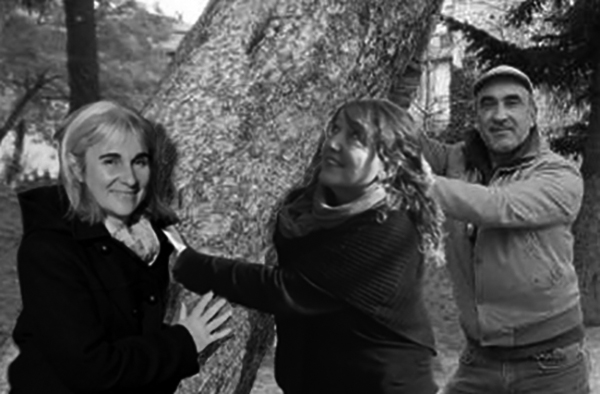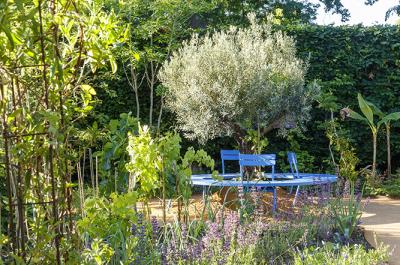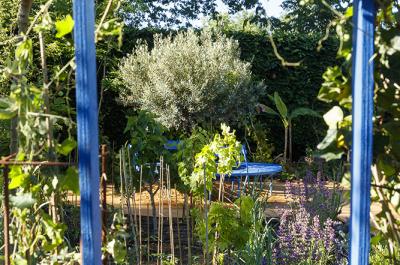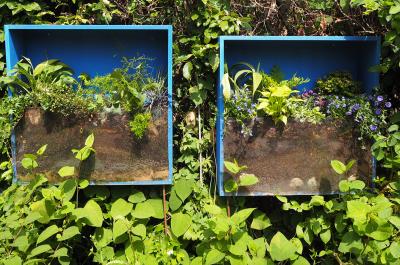The earth’s capacity for resilience and fertility still allows for an optimistic outlook. Given that we have fertile imaginations, we can still hope that our environment will remain intact, a place where life can continually renew itself. The forest has its own natural cycle. For millennia it has evolved species that are edible or otherwise useful to humanity, while maintaining its powers of protection and potential for regeneration. Like Gaia, the first goddess of Greek mythology, the forest appears as a mother ready to sacrifice herself to feed her children. Mother Earth is generous and abundant and resilience is nothing more than restoration and preservation. She tells a story of co-operation, of a necessary “eco-evolution” with the earth. We must respect her, listen to her and even imitate her, as many societies before us have known how to do. A series of potted trees, the most artificial plant shape humans have ever created, form film-stills showing a single tree gradually falling over. The tree reacts and tries to return to an upright position by stretching its branches towards the sky before disintegrating into the ground. This imbalance, which creates light and space, becomes a resource for future vegetation. It illustrates the cyclic dimension of life. Along the path, experimental micro-gardens that are both surprising and educational again illustrate biodiversity.
DESIGNERS
Catherine BAAS, environmental artist, teacher of art history at the University of Lyon 3, Jeanne BOUËT, conceptual landscape designer, and Christophe TARDY, doctor of biology, archeobotanist, paleo-environmentalist, researcher at INRAP
FRANCE

“Catherine Baas was born in Grenoble in 1967. After studying for a higher degree at the art school, she specialised in architecture and large-scale sculpture. She then moved abroad, living on several continents where she explored the plants and landscapes, filling sketchbooks with drawings, notes and photographs. For about twenty years her work has revolved around vegetation and especially trees. She has created site-specific sculptures, both temporary and permanent, for art centres and public spaces. Her many installations and exhibitions in France and abroad raise questions about our relationship with nature by weaving an intimate relationship between the viewer and the environment. Her work is always based on a close study of the site and its history. Her sculptures reveal the character of the location while drawing on the work of ethnobotanists and landscapers. Trees and nature hold both memories and meaning in her works. In our ever-changing world she invites us to contemplate the landscape.” Nicolas Bancel, historian, professor at the University of Lausanne
Jeanne Bouët was born in Lannion in 1962. She has always been drawn towards gardens, perhaps thanks to her grandparents, who were primary school teachers and who happily mixed flowers and vegetables in their garden. During her biology degree at the University in Orsay, she decided to bring together two of her passions, plants and design and become a landscape designer. She enrolled at the French School of Landscape Design in Versailles in 1983 and spent a lot of time in The King's Kitchen Garden. After several years working for landscaping practices in Paris, she had the opportunity to move to the Ardèche with her husband and children. Here she enjoyed unspoilt nature while out hiking. She developed her own landscape design business enabling her to work on urban planning and landscaping projects in her local area. She mainly works in multidisciplinary teams as she finds the differences between disciplines enriching. For a long time she has worked with local communities on zero-pesticide approaches using native plants and careful management to save money and natural resources. Passionate about saving the planet, she belongs to organic and local purchasing organisations and tree-protection movements. Helped by her family and friends, she also maintains a large plot of land where she has a kitchen garden, a pond, and an orchard where she experiments with cuttings and grafting, so she is better able to offer advice. She also uses the natural resources available in different places, such as sand, snow and leaves, to create temporary installations, or sometimes more permanent ones using willow. For those who love it, nature is a wonderful playground!
Christophe Tardy was born in 1968 in Annonay. An ecologist by training, he spent years in the Amazonian forest researching the effects of paleo-fires and slash-and-burn agriculture. After his doctorate he chose to join the world of archaeology. He moved from Nîmes to the other side of France to work on ancient wells for the French National Institute for Preventive Archaeological Research. Wells are a tremendous source of unique bio-archaeological material, which can help in the reconstruction of landscapes that have suffered the vagaries of the weather and been changed by successive human habitation. After studying at the Botanical Institute located in the very old and remarkable Botanical Gardens in Montpellier, and then being involved in creating places such as the Jardin Antique Méditerranéen in Balaruc, he knows how important it is for such places to be open to the public so they can learn about nature. He is an active member of various organisations fighting for the protection of wild places, woods and town parks, and in support of indigenous peoples who, unlike our increasingly urbanised societies, have maintained essential links and a respect for nature that continues to fight back.




